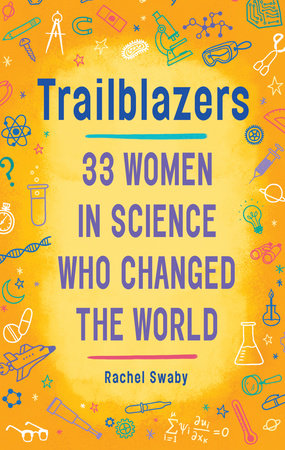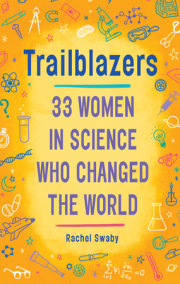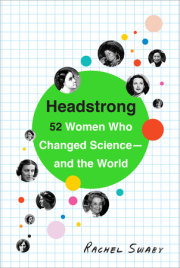Ada Lovelace
1815–1852
Mathematics • British
Ada Lovelace (born Augusta Ada Byron) was given a famous name before she made her own. Her father was Lord Byron, the bad boy of English Romantic poetry, whose epic mood swings could be topped only by his string of scandals. Only one month after the girl was born, little Ada’s mother had had enough of her father. She took the baby and quit the marriage. Lord Byron left England and never returned.
However brief their time in each other’s company, Lord Byron was ever present in Ada’s upbringing—as a model of what not to be. Worried that she might lean toward the lyrical, Ada’s math-loving mother pushed a practical curriculum of grammar, arithmetic, and spelling on the child. When Ada became sick with the measles, she was bed-ridden, and permitted to rise to a sitting position for only thirty minutes a day. Any impulsive behavior was systematically tamped down.
It may have been a strict upbringing, but Lovelace’s mother did provide her with a solid education—one that would pay off when she was introduced to the mathematician Charles Babbage. The meeting occurred in the middle of her “season” in London, that time when noblewomen of a certain age are paraded around to attract potential suitors. Babbage was forty-one when he made Lovelace’s acquaintance in 1833. They hit it off. And then he extended the same offer to her that he had to so many: come by to see my Difference Engine.
Babbage’s Difference Engine was a two-ton, hand-cranked calculator with four thousand separate parts, designed to expedite time-consuming mathematical tasks. Lovelace was immediately drawn to the machine and its creator. She would find a way to work with Babbage. She would.
Her first attempt was in the context of education. Lovelace wanted tutoring in math, and in 1839, she asked Babbage to take her on as his student. The two corresponded, but Babbage didn’t bite. He was too busy with his own projects. He was, after all, dreaming up machines capable of streamlining industry, automating manual processes, and freeing up workers tied to mindless tasks.
Lovelace’s mother may have tried to purge the girl of her father’s influence, but as Lovelace reached adulthood, her Byron side started to emerge. She experienced stretches of depression and then fits of elation. She would fly between frenzied hours of harp practice and the concentrated study of biquadratic equations. Over time, she shook off the behavioral constraints imposed by her mother and gave herself over to whatever pleased her. All the while, she produced a steady stream of letters. A playfulness emerged. She signed her letters to Babbage “Your Fairy.”
Meanwhile, Babbage began spreading the word of another project: his Analytical Engine, a programmable beast of a machine rigged with thousands of stacked and rotating cogwheels. It was just theoretical, but the plans were to far exceed the capabilities of any existing calculators, including Babbage’s own Difference Engine. In a series of lectures delivered to an audience of prominent philosophers and scientists in Turin, Italy, Babbage unveiled his visionary idea. He had convinced an Italian engineer in attendance to document the talks. In 1842, the resulting article came out in a Swiss journal published in French.
A decade after their first meeting, Lovelace remained a believer in Babbage’s ideas. With this Swiss publication, she saw her opening to offer support. Babbage’s Analytical Engine deserved a massive audience, and Lovelace knew she could get it in front of more eyes by translating the article into English.
Lovelace’s next step was her most significant. She took the base text from the article—some eight thousand words—and annotated it, gracefully comparing the Analytical Engine to its antecedents and explaining its place in the future. If other machines could calculate, reflecting the intelligence of their owners, the Analytical Engine would amplify its owners’ knowledge. It would be able to store data, and programs that could process it. She also saw the possibility for the machine to process more than numbers, suggesting that “the engine might compose elaborate and scientific pieces of music of any degree of complexity or extent.”
Reining in easily excitable imaginations, Lovelace also explained the engine’s limitations (“It can follow analysis; but it has no power of anticipating any analytical relations or truths”) and illustrated its strengths (“the Analytical Engine weaves algebraic patterns just as the Jacquard-loom weaves flowers and leaves”).
The most extraordinary of Lovelace’s annotations was her so-called Note G. In it, she explained how a punch-card-based algorithm could return a scrolling sequence of special numbers, called Bernoulli numbers. Her explanation of how to tell the machine to return Bernoulli numbers is considered the world’s first computer program. What began as a simple translation, as one Babbage scholar points out, became “the most important paper in the history of digital computing before modern times.”
Babbage corresponded with Lovelace throughout the annotation process. She sent Babbage her commentary for feedback, and where she needed help and clarification, he offered it. Scholars differ on the degree of influence they believe Babbage had on Lovelace’s notes. Some think that his mind was behind her words. Others, like journalist Suw Charman-Anderson, call her “[not] the first woman [computer programmer]. The first person.”
For what it’s worth, Babbage himself was effusive about Lovelace’s contributions. “All this was impossible for you to know by intuition and the more I read your notes the more surprised I am at them and regret not having earlier explored so rich a vein of the noblest metal.”
Lovelace possessed a strong confidence in the range of her own abilities. In one letter, she confided, “That brain of mine is something more than merely mortal. . . . Before ten years are out, the Devil’s in it if I haven’t sucked out some of the lifeblood from the mysteries of the universe, in a way that no purely mortal lips or brains could do.”
Today, we celebrate her contributions to computer science. The US Department of Defense named the computer language Ada after her. Ada Lovelace Day celebrates the extraordinary achievements of women in science, technology, engineering, and math. The Ada Lovelace Edit-a-Thon is an annual event aimed at beefing up online entries for women in science whose accomplishments are unsung or misattributed. When her name is mentioned today, it’s more than a tip of the hat: it’s a call to arms for women to take up science and math.
Hertha Ayrton
1854–1923
Physics • British
When early theatergoers nicknamed cinema “the flicks,” the name was an affectionate reference to a technological quirk. The powerful light beam directed through film strips fluttered, sending black-and-white moving images to the screen in bursts and dips. That flicker came from early projectors’ arc lighting, which was created when two carbon rods placed next to each other were electrified. The electricity jumped the gap between the two rods, causing a brilliant, if unsteady, arc. Over time, arc lighting’s flicker was verbally shortened to flick, and the name stuck despite modern cinema’s steady projections.
Arc lighting dates back to 1807, but it wasn’t until generators caught up with the technology’s needs in the 1870s that the industry could finally use it. Too bright for homes, arc lights became the go-to solution for lighthouses and other applications where very strong beams were needed. By the 1890s, they started to replace gas in streetlights. They later became famous for their place in films. Arc lights both illuminated the sets of movies like Citizen Kane and beamed early silent-film stars onto the screen.
Arc lighting should have been background, but because the lights hissed and sputtered, they claimed a prominent part in every production. The ruckus occurred in the light’s rods. When they were electrified, carbon evaporated and a tiny hole formed. As air rushed into the divot, it created a whine. As a result, arc-light attendants were always busy, constantly tweaking and adjusting the rods in an effort to coax them into doing their job without too much of a hiss.
Scientists like Hertha Ayrton, a British inventor and physicist, and her husband, William, an electrical engineer, started working toward a quieter and more consistent arc light in the late 1800s. Unfortunately, their work went up in flames when it was mistaken for kindling, crumpled by the maid, and tossed into the fireplace. (No word on whether the fire burned brighter.) Ayrton’s husband was away in the United States on business, so Ayrton restarted the research by herself.
She began by mounting a thorough investigation. By understanding the process’s intricacies, she hoped to identify the problem and figure out how to engineer the light in a way that would cut the hiss and flicker.
When she discovered that the rod was the problem, Ayrton designed one shaped for quieter use. Along the way, Ayrton also learned about the light’s flutter and how the relationship between the voltage drop across the arc, the arc’s length, and the current affected it. In 1895 and 1896, she published twelve papers in the Electrician that explained her findings.
Ayrton demonstrated her work on arcs for the Royal Society in 1899. A newspaper gushed that the “lady visitors” were “astonished . . . one of their own sex [was] in charge of the most dangerous-looking of all the exhibits—a fierce arc light enclosed in glass. Mrs. Ayrton was not a bit afraid of it.”
Members of the Royal Society, however, were a bit afraid of her. When Ayrton’s paper “The Mechanism of the Electric Arc” was accepted in 1901, the society recruited a male member to publicly present it, because women weren’t allowed. A year later, she earned a nomination to join the society, but the group consulted a lawyer who decided that her gender made her ineligible. According to English common law, a married woman had no legal standing separate from her husband’s.
Ayrton thought that the discrimination she faced was utter nonsense. “Personally I do not agree with sex being brought into science at all,” she explained to a journalist. “The idea of ‘women and science’ is entirely irrelevant. Either a woman is a good scientist or she is not; in any case she should be given opportunities, and her work should be studied from the scientific, not the sex, point of view.”
Ayrton was one of the good scientists. Her 450-page book, The Electric Arc, became the standard on arc lighting nearly as soon as it was published in 1902. But it wasn’t until two years later that the Royal Society allowed Ayrton to read a paper of her own. Finally, the organization gave Aryton some recognition. In 1906, Ayrton was awarded the society’s Hughes Medal “for an original discovery in the physical sciences, particularly as applied to the generation, storage and use of energy.” Membership, however, was still out of her reach.
Until 1918, women weren’t allowed to vote in England. Informed by her own early poverty and continuing experience with sexism, Ayrton was an outspoken advocate for women’s voting rights, operating with authority, charm, and presence. She cared for suffragist hunger strikers and refused to participate in the 1911 census. Across the official census form she wrote, “How can I answer all these questions if I have not the intelligence to choose between two candidates for parliament? I will not supply these particulars until I have my rights as a citizen. Votes for women. Hertha Ayrton.”
Ayrton was one of a small club of women attempting to gain acceptance in overwhelmingly male scientific institutions. Ayrton counted Marie Curie among her closest friends and often stuck up for the chemist’s reputation publicly. “An error that ascribes to a man what was actually the work of a woman has more lives than a cat,” wrote Ayrton in response to claims that Curie’s husband, Pierre, was really the brains behind their scientific discoveries. When Pierre died in 1906 and Ayrton’s husband, William, died in 1908, both women went on to prove that though their husbands were valued collaborators, they were highly skilled scientists on their own.
Science was actually Ayrton’s second career. Before her exploration into arc lighting, she was an inventor, patenting a device that would divide a line into equal segments. (Some biographers ascribe her affinity for tinkering to her watchmaker father.) During World War I, dismayed by reports of chlorine gas being used on British soldiers, she was drawn to invention again. The self-assigned task was this: how could she protect soldiers from the noxious gas? To experiment with a variety of methods, Ayrton staged a miniature war zone in her drawing room, with matchboxes serving as trenches, and cooled smoke (produced from brown paper lit on fire) standing in as gas. Ayrton poured the smoke over the circuit to see how it would behave. There she refined what she believed to be the best solution—essentially a big fan. It looked like a long broomstick topped by a large rectangular paddle, designed to force the gas away when flapped manually.
The military was initially skeptical. The organization’s hang-ups partly had to do with the invention’s name. “Fans” were objects that women carried. How could they protect men at war? It took a couple of years and a demonstration in the field in 1917, but the military finally put the devices to use; some one hundred thousand were eventually shipped to the western front. Two years later, Ayrton completed an automatic version to force away gas carried on more powerful winds.
Ayrton was a creative problem solver. She had the flexibility and skills to tackle a hiss, a flicker, or a deadly gas, whether it required a set of pillboxes or the principles of physics.
Hedy Lamarr
1914–2000
Technology • Austrian
When Hedy Lamarr (born Hedwig Kiesler) was a child, she wandered the streets of Vienna with her father, listening to him explain the inner workings of complicated machines like streetcars and printing presses. He put a high value on independence: “[My father] made me understand that I must make my own decisions, mold my own character, think my own thoughts.” He provided her with marching orders to find her own way in the world. When Lamarr made the decision to leave school at sixteen and move to Berlin to pursue acting, she knew her father would not stop her.
Lamarr quickly made a name for herself on the stage and screen. But her ascent was not without snags. She married a wealthy (and persistent) munitions dealer named Friedrich “Fritz” Mandl, who promptly forced her to quit her public career as an actress. He wanted her at home. Becoming an accessory used to thrill her husband’s powerful friends, however, did not suit her. “Any girl can be glamorous,” Lamarr said. “All you have to do is stand still and look stupid.”
Before long, Lamarr began plotting her escape. “I’ve never been satisfied,” said Lamarr. “I’ve no sooner done one thing than I am seething inside to do another thing.” While she performed her act as a well-coiffed houseplant, she paid careful attention to the sensitive conversations her husband was having with his guests, who included diplomats, politicians, generals, and the fascist Italian prime minister Benito Mussolini. Lamarr planned to leverage any intelligence she’d gathered against her controlling husband, should he refuse to allow her to quit the marriage. It never came to that. By 1937, after Mandl stormed off to one of his hunting lodges following a fight, Lamarr left for London with two large trunks, two small ones, three suitcases, and as much jewelry as she could carry. (Money was difficult to take out of the country.) Upon arriving, she was able to arrange an introduction to the head of MGM Studios, Louis B. Mayer, the executive with the largest salary in the United States. They met at a small party. Unlit cigar in hand, he offered her a $125-a-week contract with MGM if she could find her own way to California. Lamarr turned him down. Lamarr knew her value—and it was more than he was offering.
Copyright © 2016 by Rachel Swaby. All rights reserved. No part of this excerpt may be reproduced or reprinted without permission in writing from the publisher.







